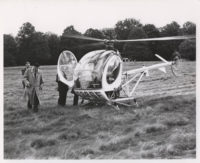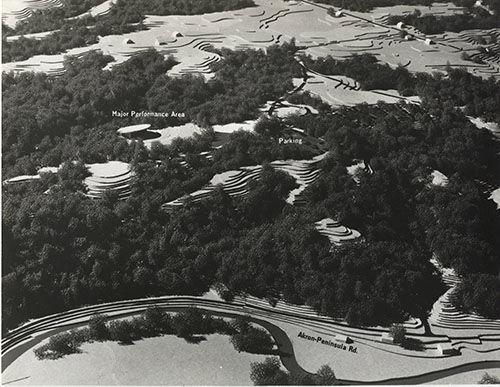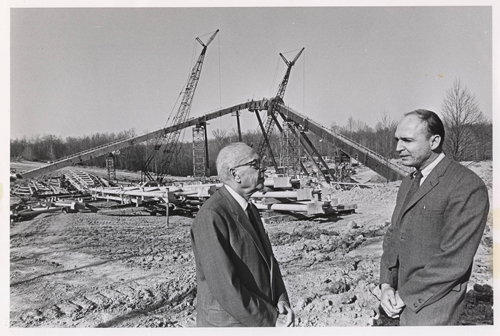by Alice Koeninger

At Blossom’s conception, The Cleveland Orchestra was the only “Big Five” orchestra in the country that did not offer full-time positions to its musicians, mainly due to the fact that it did not have a summer home. In 1965, it became musical director George Szell’s mission to build such a residence, and the Musical Arts Association was finally listening.
Soon, Frank E. Joseph, Szell’s friend and board president, along with Beverly Barksdale, the Orchestra’s general manager, began looking at possible sites for that outdoor venue.
They examined over 80 different sites in their two-year search, and ultimately decided on more than 500 acres of woodland, north of Akron and south of Peninsula, with a bowl-shaped valley perfect for an amphitheatre. This decision came after increasing pressure from the city to create a summer location for its beloved orchestra, and after 98 of the ensemble’s 111 members voted to approve a contract that brought the musicians closer to year-round employment.
In addition to providing a summer concert venue, the project envisioned an educational component from the beginning. It was Szell’s dream to create the Blossom Festival School, headed by associate conductor Louis Lane, that would train students in chamber music. By enlisting orchestra members to coach chamber music and teach private lessons, Szell intended for the musicians to pass on his philosophy that TCO performs as one big chamber ensemble.
In an interview last month with this publication, Kent/Blossom Festival director Ricardo Sepulveda said, “They originally planned to build the school next to Blossom with a space for performances, classrooms, and practice rooms, but since Kent State had just opened a new music building only 10 miles away, they opted for locating the school there instead.”
Blossom could be described as TCO’s “problem child.” In 1966, the Musical Arts Association struck a deal with the Seibert Development Enterprises, Inc. to expand the area around the site to almost 1500 acres. This land was originally intended for golf courses and a residential area, but was promised to the MAA unless Seibert had obtained other financial commitments for the development of the land. In 1968, the deadline for those commitments had passed, but Seibert refused to give up the land, leading to a publicized lawsuit between Blossom and Seibert Development Enterprises. In the end, they settled on the original plan of around 500 acres, which protected the land around Blossom from development and noise pollution.
Then there was the problem of raising the money to build the actual concert venue. At its birth, Blossom Music Center was estimated to cost $2-3 million. The Blossom family, who had a history of supporting the orchestra, donated $1.3 million. The board voted unanimously to name the site after the family as a thank-you for their generosity. Some were concerned that “Blossom” sounded too much like a flower, but all eventually agreed that Blossom carried enough weight since it was a family name, and not made-up.
Szell’s concerns and requirements for the amphitheatre would impact the budget — his desires included airconditioning the open-air stage, hiring an acoustician, and having personal input on all the designs. The architectural firm of Schafer, Flynn, and van Dijk were entrusted with the plan for the complex. Peter van Dijk was commissioned to design the pavilion, and Christopher Jaffe was retained as the acoustician. Szell put pressure on all involved parties to make rapid progress.
Then, there was the issue of providing water on the Blossom grounds. No matter how deep wells were dug, the engineers could not find a sufficient supply of water. A large water main had to be installed, adding to the cost of utilities.
Ultimately, the music prevailed over the physical challenges. The idea for Blossom’s design stemmed from the desire for music to be made accessible to as many people as possible. Szell said, “The whole idea of the Blossom Festival is to give the greatest possible number of people the opportunity to hear the orchestra. I believe the Blossom Music Center will become, almost overnight, one of the important summer music festivals of the world.”
Stay tuned for the excitement of Blossom’s celebrity-filled first season, coming next week.
This article was based on material from the Cleveland Orchestra Archives and Donald Rosenberg’s book, The Cleveland Orchestra Story.
Published on ClevelandClassical.com July 3, 2018.
Click here for a printable copy of this article





